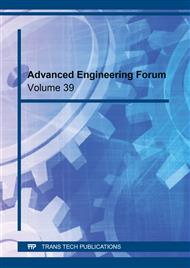[1]
Galvez J.C, J.M. Benitez, B. Tork, M.J. Casati, D.A. Cendon, Splitting failure of precast prestressed concrete during the release of the pre-stressing force, Engineering Failure Analysis,, Volume 16, December 2009, pp.2618-2634.
DOI: 10.1016/j.engfailanal.2009.04.023
Google Scholar
[2]
Arnold M., R.J. Peterman, N.N. Bodapati, B. Terry Beck, C.H.Wu, Development of a Standard Bond Test for Indented Prestressing Wires,, Paper Number JRC2013-2461, Proceedings of the 2013 ASME Joint Rail Conference, April 25-18, 2013, Knoxville, Tennessee USA.
DOI: 10.1115/jrc2013-2461
Google Scholar
[3]
Beck, BT, Robertson, AA, Peterman, RJ, Savic, A, Wu, CJ, Riding, KA, & Bloomfield, J. A High-Resolution Automated Prestressing Wire Indent Profiling System for Verification of Wire-Concrete Mix Compatibility., Proceedings of the 2019 Joint Rail Conference. 2019 Joint Rail Conference. Snowbird, Utah, USA. April 9–12, 2019. V001T01A009. ASME. https://doi.org/10.1115/JRC2019-1269.
DOI: 10.1115/jrc2019-1269
Google Scholar
[4]
Adrijana Savic, Developing a prism qualification test to ensure adequate splitting resistance in pretensioned concrete railroad ties,, August (2019).
Google Scholar
[5]
Savic, A, Beck, BT, Robertson, AA, Peterman, RJ, Clark, J, & Wu, C (. Effects of Cover, Compressive Strength, and Wire Type on Bond Performance in Prismatic Prestressed Concrete Members., Proceedings of the 2018 Joint Rail Conference. 2018 Joint Rail Conference. Pittsburgh, Pennsylvania, USA. April 18–20, 2018. V001T01A007. ASME. https://doi.org/10.1115/JRC2018-6153.
DOI: 10.1115/jrc2018-6153
Google Scholar
[6]
Savic, A, Beck, BT, Shafiei Dastgerdi, A, Peterman, RJ, Riding, K, & Robertson, AA. The Effect of Wire Type on Cracking Propensity in Prestressed Concrete Prisms., Proceedings of the 2019 Joint Rail Conference. 2019 Joint Rail Conference. Snowbird, Utah, USA. April 9–12, 2019. V001T01A002. ASME. https://doi.org/10.1115/JRC20auditory system19-1234.
DOI: 10.1115/jrc2019-1234
Google Scholar
[7]
Shafiei Dastgerdi, A, Savic, A, Peterman, RJ, Riding, K, & Beck, BT. Evaluation of Splitting Crack Propagation in Pre-Stressed Concrete Ties Made with Different Types of Coarse Aggregate., Proceedings of the 2019 Joint Rail Conference. 2019 Joint Rail Conference. Snowbird, Utah, USA. April 9–12, 2019. V001T01A015. ASME. https://doi.org/10.1115/JRC2019-1280.
DOI: 10.1115/jrc2019-1280
Google Scholar
[8]
Marija Krstic, Julio F. Davalos Field Application of Recycled Glass Pozzolan for Concrete, ACI Materials Journal Volume116 Issue 4 Pages 123-131.
DOI: 10.14359/51716716
Google Scholar
[9]
Marija Krstic Macro- and Microstructure Evaluations and Field Applications of Concrete with Recycled Glass Pozzolan, Doctoral Thesis.
Google Scholar
[10]
Murphy, Robert L., Determining the Transfer Length in Prestressed Concrete Railroad Ties Produced in the United States,, Master Thesis, 2012, Kansas State University, Manhattan, Kansas, USA.
Google Scholar
[11]
MA Zaki, HA Rasheed, RR Roukerd, M Raheem, Performance of reinforced concrete T beams strengthened with flexural CFRP sheets and secured using CFRP splay anchors,. Engineering Structures 210, 110304.
DOI: 10.1016/j.engstruct.2020.110304
Google Scholar
[12]
Wu C.-H., Zhao W., Beck T. and Peterman R. Optical Sensor Developments for Measuring the Surface Strains in Prestressed Concrete Members, Journal of Strains, 47, Supp. 1, pp.376-386, (2011),.
DOI: 10.1111/j.1475-1305.2009.00621.x
Google Scholar
[13]
Mark Haynes, John C.-H. Wu, B. Terry Beck, and Robert J. Peterman Non-Contact Measurement of Wire Indent Profiles on Prestressing Reinforcement Steel, Proceedings of the 2012 AREMA Conference, Sept. 16-19, 2012, Chicago Illinois, USA.
DOI: 10.1115/jrc2014-3800
Google Scholar
[14]
Weixin Zhao, Kyle Larsan Robert J. Peterman,B. Terry Beck, and C.-H.John Wu, Development of a laser-speckle imaging device to determine the transfer length in pretensioned concrete members, PCI Journal Winter 2012, pp.135-143.
DOI: 10.15554/pcij.01012012.135.143
Google Scholar
[15]
B. Terry Beck, Aaron A. Robertson, Naga Narendra B. Bodapati, Robert J. Peterman, Chih-Hang John Wu, Kyle A. Ryding, Utilization of High-Resolution 3D Optical Scanning of Crossties to Assess Cross-Sectional Parameters and the Effects of Long-Term Abrasion and Wear,, Paper Number: JRC2016-5753, Proceedings of the 2016 Joint Rail Conference, Columbia, South Carolina, April 12-15, (2016).
DOI: 10.1115/jrc2016-5753
Google Scholar
[16]
Aref Shafiei, Kyle Riding, Robert J. Peterman, Chris Christensen, B. Terry Beck, Suitability and Variability of Non-Destructive Testing Methods for Concrete Railroad Tie Inspection,, Paper Number JRC2016-5776, Proceedings of the 2016 Joint Rail Conference, April 12-15, 2016, Columbia, SC, USA.
DOI: 10.1115/jrc2016-5776
Google Scholar


